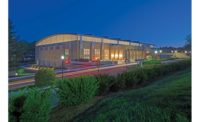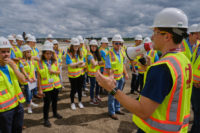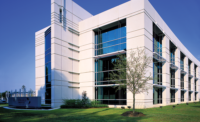For North Little Rock, Ark.-based Garver, a design firm specializing in transportation, sewerage and water supply across the region, 2019 was a year of multiple successes.
Not only did the firm celebrate its centennial year, but it experienced 25% year-over-year growth across Arkansas, Louisiana, Mississippi, Oklahoma and Texas, pushing its regional revenue up to $123.2 million. This also lifted the firm’s ranking on ENR Texas & Louisiana’s Top Design Firms list up two spots from last year to No. 22.
“Our centennial year was also a time of organic growth for Garver. We currently have more than 700 full-time employees company-wide and hired more than 140 people in the region last year,” says Brock Hoskins, president and CEO.
To handle the nearly 1,800 projects the firm completed in 2019, Garver opened new offices throughout the year in Olive Branch, Miss., New Orleans, Oklahoma City and College Station and El Paso, Texas. “In 2020, that has continued with office openings in Rogers, Ark., and Gulfport, Miss.,” Hoskins adds.
Projects Aplenty
2019 contracts included a $72-million job for the Texas Dept. of Transportation (TxDOT) to provide plans and specifications for frontage roads from West of Cockrell Hill Road to Hampton Road on Interstate 20 in Dallas County and a $70-million taxiway rehabilitation effort at George Bush International Airport in Houston, construction of which will end in 2023.
“In Texas, we’ve got a $77-billion, 10-year unified transportation plan. That is basically our work program for the next 10 years,” explains Marc Williams, TxDOT deputy executive director. “We rely heavily on companies in the engineering community to help us do the project development work, the environmental work, the construction and the inspection necessary to deliver that program that averages between $7 billion and $8 billion a year.”
Garver began working for TxDOT in 2007 with aviation design, then expanded into highways in 2017.
“I believe they’re doing work in about 12 of our 25 districts right now,” he says. “They’ve been an important partner whose service area has grown pretty significantly in the state of Texas.”
“A lot of engineering firms can design new bridges—we can too— but we also know how to design complex repairs to wood, steel and concrete bridges.”
– Jerry Holder, Director of Transportation, Garver
Right now, Garver is conducting the I-35 NEX schematic and environmental study for a major widening and rehabilitation project in the San Antonio area.
“They’re also doing what we call the ports to planes interstate feasibility study, which is a planning study to potentially extend I-27 where it terminates in Lubbock down all the way to the Texas-Mexico border,” Williams says. “Then they’ve got several other important widening and reconstruction projects on interstates and major highways around the state.”
Over the last 20 years, Garver has developed a team of bridge repair experts, explains Jerry Holder, Garver’s director of transportation.
“A lot of engineering firms can design new bridges—we can too—but we also know how to design complex repairs to wood, steel and concrete bridges,” he says. “Our clients have tight budgets and can’t afford to tear down a bridge and replace it with a new one every time. We have helped them extend the life of their bridges by inspecting the bridges and designing repairs to add another 10 years to the service life.”
Garver recently helped Dallas-Fort Worth International Airport repair several problem bridges leading into the terminals.
One of Garver’s largest recent projects is the Lake Thunderbird Water Reuse – Field Research Project for Inland Indirect Potable Reuse in Norman, Okla. This pilot study, one of four water reclamation and reuse studies backed by a U.S. Bureau of Reclamation grant, is expected to be complete in 2022.
In Enid, Okla., Garver is program manager, lead designer and site representative for the Alternate Water Supply Program at Kaw Reservoir. Construction on this $315-million program is expected to begin in 2021.
The firm is providing design services for part of the Gilcrease Expressway Turnpike in Tulsa, including a segment of toll road that connects I-44 in southwest Tulsa with U.S. 412 in west Tulsa. It entails new quarter-mile bridges over the Arkansas River and Berryhill Creek.
In Mississippi, Garver is working on the County Road 221 Bridge over the Skuna River for the Yalobusha County Board of Supervisors, the design for which should be ready in 2021.
Garver also has a five-year engineering services contact with the Monroe Regional Airport (MLU) in Monroe, La.
“We had a runway extension project that we were getting ready to start,” recalls Ron Phillips, MLU airport director. Garver is lead engineering firm on that $13-million, two-phase project. It will allow commercial service operations to use both runways. Previously, if the primary runway was closed for maintenance, the airport had to cancel flights.
“They were absolutely fantastic,” Phillips says. “I’ve been with the airport for 13 years and in those 13 years, that is one of the projects that we had very few problems on. Garver came highly recommended by several people that we respect throughout the industry. They had a stellar reputation, and they have lived up to that.”
Phase 1 of the Runway 14-32 project was completed in 2019, and Phase 2 will be complete in 2021. Garver is also serving as engineer on taxiway delta construction, drainage improvements and an airport master drainage study for MLU.
Looking Ahead
Garver celebrated its centennial year by giving back to the communities it serves and hoping to inspire the next generation of engineers.
Throughout the year, Garver donated chain-reaction STEM kits and funds to 100 schools across its multistate footprint, and its engineers worked alongside more than 1,000 students at school events to build Rube Goldberg-style chain reaction machines.
“An estimated 14,000 students were reached through the STEM kits and funding from Garver,” says Michael Graves, Garver’s COO.
The firm’s corporate giving program, GarverGives, in 2019 supported more than 320 organizations, contributed more than $324,000 and devoted more than 800 employee community service hours, says Graves.
The firm also takes care of its own with Garver Wellness, a program launched in 2006 and led by an in-house team that is dedicated to improving employee health, reducing long-term health risks and promoting a culture of well-being. The program boasts a 99% participation rate.
“Garver has a long history of investing in our employees. They are the most valuable asset we have,” Graves says.
At the beginning of 2020, Garver launched its five-year strategic plan, which “outlines deliberate actions that benefit our employees, our clients and our company under a variety of market conditions,” Hoskins says.
The company’s leadership expects Garver will continue to grow and succeed for the same reasons it has for a century—by focusing on offering the best employee experience.
“Our employees are highly motivated and demonstrate a passion to build Garver into an even stronger company,” Hoskins says. “I think clients see that in our work and appreciate who we are. I truly believe our employee-centered culture is what makes our firm successful.”
Looking forward, Hoskins foresees some project delays and lack of funding due to reduced tax revenue as a result of the COVID-19 pandemic.
“The industry may have a slightly larger percentage of its people working remotely going forward, which may help firms conserve cash as office expansions may be reduced or delayed,” he says. “Despite the obvious challenges presented by the COVID-19 situation, addressing obstacles forced us to focus on resiliency and become even more agile as a firm.”
The plan is for the company to continue to focus on growing organically while pursuing projects that are of most importance to its clients, Hoskins says.
“We treat each other more as family than co-workers at Garver,” Holder says. “I think we stay competitive because we hire with our culture in mind.”









